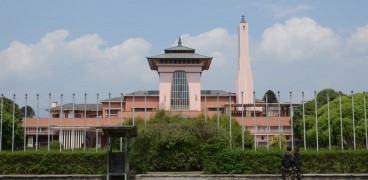Budhanilkantha Temple in Budhanilkantha, Nepal is a Hindu open-air temple dedicated to Lord Vishnu. The word Budhanilkantha stands for Old Blue Throat in English.
The Budhanilkantha Temple is built below the Shivapuri Hill at the northern end of the Kathmandu Valley, and a massive reclining statue of Lord Vishnu marks this temple. Budhanilkantha's principal figure of the temple is considered Nepal's highest stone carving.
Where is the Budhanilkantha Temple?
The Temple of Budhanilkantha, also known as the Temple of Narayanthan, is situated in Kathmandu. Located in the northernmost part of the Kathmandu Valley, at the foot of the Shivapuri hills, Budhanilkantha is about 8 km from the area.

Buddhanikantha: Sacred Stillness Embodied
Credit:Nepaltravellers.com
While this temple is called Budhanilkantha, its name does not derive from the Buddha; Budhanilkantha stands for "Old Blue Throat" instead.
The statue symbolizes Lord Vishnu, who along with Brahma and Shiva is considered one of the 'Trimurtis.'
How can we reach the Budhanilkantha temple?
Some several buses and vans offer transportation from central Kathmandu, but you can also travel the entire way to Budhanilkantha or rent a taxi.
There are a few restaurants and cafés farther up from the temple just until you enter the shrine where you can pause for a cafe or a dinner. The air is cleaner up here, and a hike can be very refreshing in Shivapuri National Park.
God of Budhanilkantha Temple
The principal statue is a black stone frame built from a single black basalt base. The monument stands 5 meters tall (about 16.4 feet) and is positioned in the centre of a recessed water pool which is 13 meters deep.

Buddhanikantha: Divine Serenity Captured
Credit:Advicetraveller.com
It shows the god reclining on the divine serpent, Shesha's coils. He keeps in his four hands the Sudarshana Chakra, a Conch Shell, a club, and a gem.
He is well crowned with a crown decorated with several pictures of Kirtimukha and can also be seen alternating with a silver crown. A priest attends typically to accept offerings from devotees at the foot of the painting.
The Budhanilkantha Temple is a place of religious significance for followers of both Hinduism and Buddhism and is regarded as a perfect example of religious harmony.
History behind Budhanilkantha Temple
According to ancient Hindu scriptures, a farmer and his wife were once ploughing their field when they struck a figure in the grounds, causing it to bleed in the farm.
This turned out to be the image of Budhanilkantha's missing god, who has been retrieved and put in his present location.
Another tradition says that during the reign of the seventh-century ruler Vishnu Gupta who ruled the Kathmandu Valley under the Lichchhavi King Bhimarjuna Dev, the statue was sculpted and taken to its present position in Kathmandu.

Buddhanikantha: Tranquil Deity Presence
Credit:Pariskathmandu.com
For several years the authorities suggested that the statue would remain afloat in the pool of water. In reality, the assertion was not proven or debunked by limited exposure to scientific rigour in 1957. Still, a tiny statue chip showed it to be silica-based stone but with a relatively low density comparable to lava rock.
The floating figure of Vishnu appears to fascinate, and the number of corresponding access requests to research its physical identity has been diminished to date.
Belief related to Rulers of Nepal
A legend states that there was a prophetic vision of King Pratap Malla (1641–1674). That vision led him to believe that if they visited the Budhanilkantha Temple, the kings of Nepal would die.
Nepali monarchs have never visited the temple in fear of prophecy, after King Pratap Malla.
Important Festivals Celebrated in Budhanilkantha Temple
The Budhanilkantha Temple has been the location where on the 11th day of the Hindu month of Kartika (October – November) Haribondhini Ekadashi Mela is conducted.

Buddhanikantha: Serenity in Stone
Credit:advicetraveller.com
It is attended by thousands of pilgrims and is the main festival of the temple in celebration of Lord Vishnu's awakening from his long sleep.
Interesting Facts about Budhanilkantha Temple
- Budhanilakantha is a Sanskrit term meaning 'Old Blue Throat,' a title granted by gods to Lord Shiva after the Lord had drunk poison to save the planet.
- The temple houses Lord Vishnu's largest and most magnificent stone-carved idol in the world believed to have been built from a single block of undisclosed black basalt stone.
- The carving is 5 meters tall and is in a relaxing place in a 13-meter deep pool often called the 'cosmic sea'.
- It was assumed that the Vishnu idol in the lake was carved during the reign of king Vishnugupta of the 7th century, who ruled the Kathmandu valley, 1,400 years ago.
- Records also indicate a farmer and his wife later rediscovered the temple during the early Malla Dynasty era.
- Urban tradition explains the presence of Lord Shiva's mirror-like reflection at the underside of the statue.
- It is assumed that the water in Budhanilakantha came from Gosainkunda, a lake created as a consequence of Lord Shiva's trident striking with the mountainside.
- Every year even a major fair is conducted at Budhanilkantha on the auspicious days of Ekadashis, Harishayani, and Haribodhini, representing Lord Vishnu's 4-month sleeping time as Hindus believed.
- Thousands of pilgrims visit the Budhanilkantha temple during Haribondhini Ekadashi, conducted on the 11th day of the Hindu month of Kartik (October-November).
- The image of Lord Vishnu has a close attribute to that of Lord Buddha.
















